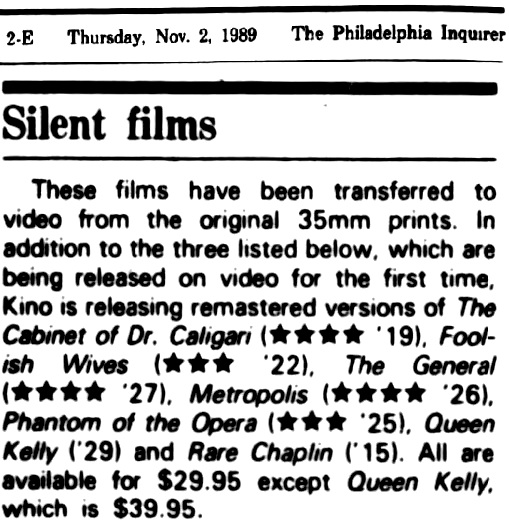| Return home |  |
Return to previous page |
1965: The 2nd Nordwestdeutscher Filmverleih
(NWDF) Edition
(NWDF) Edition
Here is a peculiar VHS that offers no indication of its source, except for a Kino copyright claim.
This was driving me crazy for the longest time.
I had guessed it was from the mid or late 1950’s and I had guessed it was recorded in SoCal or NYC.
Wrong on all counts!
As you can guess from the heading above, I now know what this oddball item is.
Nonetheless, let’s go through the investigation, step by step.
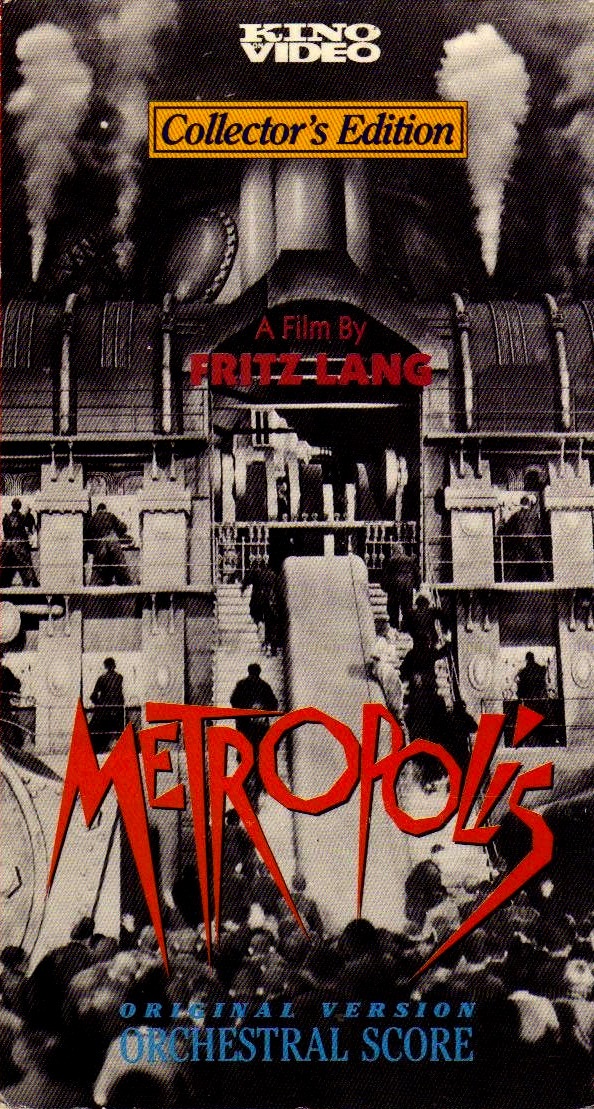 I just purchased the Kino on Video “Collector’s Edition” VHS from 1989,
with the year 1989 plastered all over the cover and the opening of the movie.
“Orchestral Score” boasts the front cover,
and “Original Music Score Added” explains the back cover.
This is taken from a 35mm dupe of a BFI print.
Predictably, the left side is lopped off to make room for the music track,
since Ufa had printed its 1936 lavender through a .723"×.864" sound aperture
(same as Movietone or Photophone) rather than a silent aperture.
I just purchased the Kino on Video “Collector’s Edition” VHS from 1989,
with the year 1989 plastered all over the cover and the opening of the movie.
“Orchestral Score” boasts the front cover,
and “Original Music Score Added” explains the back cover.
This is taken from a 35mm dupe of a BFI print.
Predictably, the left side is lopped off to make room for the music track,
since Ufa had printed its 1936 lavender through a .723"×.864" sound aperture
(same as Movietone or Photophone) rather than a silent aperture.
Curiously, this edition is slightly trimmed, deliberately.
For instance, at the Eternal Garden, the moment when the panicked maître d’
rushes over to shoo Maria and the urchins away, well, that’s gone.
A few split seconds of the Moloch scene are also snipped away.
Titles that originally lasted, say, four or five seconds, are in this edition reduced to maybe one or two seconds.
Altogether, those little alterations shaved some four minutes off of the running time.
I have no clue who did that, or who would have done such a nutty thing, or why.
When Kino transferred the print to video, the crew lopped off the height to get the image back to the shape of a standard TV screen.
It is washed out and flickery, a truly unpleasant visual experience,
and yet it is far superior to almost any other VHS release.
UAMA, the University of Arizona Museum of Art & Archive of Visual Arts,
presented this Kino VHS sometime after 2002 and before 2010, and printed
program notes,
but did not identify Kino’s source or the composer.
An excerpt from the Kino VHS of 1989.
I spent months driving myself crazy trying to identify the jazz band, the original release date, and the original distributor.
I thought I found a clue, and I did find a clue, but it was the wrong clue.
It was a post by
Kazoo the Clown on 4 July 2008
on a message board entitled
slashdot.
Instead of providing a clue I could chase down, it revealed that there was yet another jazz score recorded for this movie.
This is the message:
|
...the first time I saw it was at the old Fox Venice theater in the 1970s,
and the soundtrack it had was a very interesting Jazz score that I really liked —
the beginning portion where the workers are entering the elevators like lemmings
had this piano part that alternated between two low notes and was very stark —
matched the film perfectly I thought.
Since then I've always been looking for a copy of it with that soundtrack, but to no avail —
I bought a couple of VHS copies when they were first available,
and all were poor quality picture with either an ancient classical track or something else —
when the Giorgio Moroder version came out in the ’80s, that’s all you could find anywhere,
so it really dashed my hopes of finding the obscure jazz version I first saw....
|
The jazzy print that Kino transferred in 1989 does not use jazz or a piano during that scene.
It uses a Gregorian chant mixed with some sound effects.
So I’m confused.
Anyway, this mystery edition played at the
Fox Venice on
Wednesday, 6 September 1978 and may or may not have played a couple more days.
So, what did the Fox Venice show?
Was it perchance the 16mm Amba Pictures edition?
In my searches high and low to identify the edition on the 1989 Kino VHS, I discovered fascinating web pages about the movie,
most of them defunct.
They offer no help at all in solving this particular mystery.
Aitam Bar-Sagi, “Area 51”
Olaf Brill & Thomas Schultke, “The Internet Source Book for Early German Film: Metropolis”
Augusto Cesar B. Areal, “Fritz Lang’s Metropolis”
Augusto Cesar B. Areal, “Fritz Lang’s Metropolis: Notes and Additional Texts”
Augusto Cesar B. Areal, “Metropolis: The released versions”
Augusto Cesar B. Areal, “Metropolis: Comments about the Soundtracks (with emphasis on Moroder’s)”
Cyranos, “Metropolis”
Glenn Erickson, “Metropolis — Restored Authorized Edition”
Brian May, “Metropolis — the film”
Michael Organ, “A Compendium of Resources on Fritz Lang’s Metropolis (1927)”
Douglas Quinn, “Metropolis Home Page”
Douglas Quinn, “Yes, Virginia, there are different versions...”
Douglas Quinn, “Where can I get Metropolis stuff?”
Olaf Brill & Thomas Schultke, “The Internet Source Book for Early German Film: Metropolis”
Augusto Cesar B. Areal, “Fritz Lang’s Metropolis”
Augusto Cesar B. Areal, “Fritz Lang’s Metropolis: Notes and Additional Texts”
Augusto Cesar B. Areal, “Metropolis: The released versions”
Augusto Cesar B. Areal, “Metropolis: Comments about the Soundtracks (with emphasis on Moroder’s)”
Cyranos, “Metropolis”
Glenn Erickson, “Metropolis — Restored Authorized Edition”
Brian May, “Metropolis — the film”
Michael Organ, “A Compendium of Resources on Fritz Lang’s Metropolis (1927)”
Douglas Quinn, “Metropolis Home Page”
Douglas Quinn, “Yes, Virginia, there are different versions...”
Douglas Quinn, “Where can I get Metropolis stuff?”
As you could hear, the accompaniment is not an orchestral score at all;
it is a jazz band playing various styles of music but mostly hard bop.
Bits and pieces are nice, but overall I had hardly anything good to say about this.
I griped that it did not fit the movie, that it was inappropriate.
I postulated that perhaps the band and composer were too ashamed to take credit.
Well, I just learned who wrote this score.
Gulp.
It was one of my favorite composers, one of my favorite film accompanists: Konrad Elfers.
Make a monkey out of me.
He recorded this score in
1965,
which postdates my guess by a full decade.
How do we learn this?
We learn this by spending yet more money to purchase the British Thorn EMI VHS of (probably) 1982.
Proof? You want proof? Here’s proof:
The opening of the Thorn EMI VHS edition.
Nordwestdeutscher replaced the BFI opening credits with its own.
This was a slightly trimmed copy of the BFI edition,
and so this was definitely a generation further removed.
There is a prominent BRITISH FILM INSTITUTE credit at the end.
This was surely issued by Nordwestdeutscher Filmverleih,
and it was surely someone at Nordwestdeutscher Filmverleih who made the trims.
The following year, the Friedrich-Wilhelm-Murnau-Stiftung inherited this 1965 version,
which seems to have become its standard for the next 20 years or so.

The BFI shot this End title for insertion into its silent prints, but for Metropolis, which Ufa had cropped in 1936, that didn’t match, and so the left side was lopped off on the Nordwestdeutscher copy.
To my utter surprise, I discover that portions of Elfers’s score were reused
for a reissue of the Paul Strand/Charles Sheeler short from 1921,
Manhatta.
When did that first happen?
Who was responsible?
Was the music licensed?
If you buy Kino on Video’s DVD set from 2005, Avant-Garde: Experimental Cinema of the 1920s and ’30s,
that is the music you will hear accompanying Manhatta.
Was it Kino that created that mix for the DVD set?
In my opinion, the music fits Manhatta much better than it fits Metropolis.
|
The Clue
|
|
|
Griggs Moviedrome 16mm, 1960, issued on Hollywood Home Theatre VHS circa 1980 |
Nordwestdeutscher, 1965, issued by Kino on VHS in November 1989 |
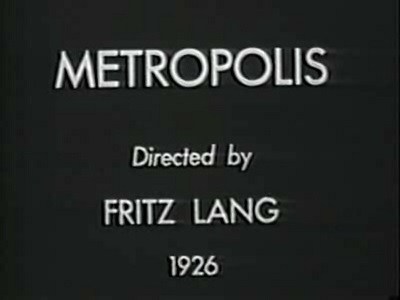 If you have seen MoMA prints, this font and main title style should look awfully familiar. |
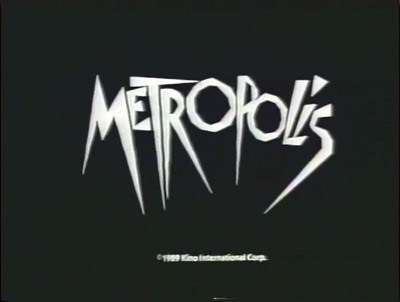 Kino replaced the main title with its own. |
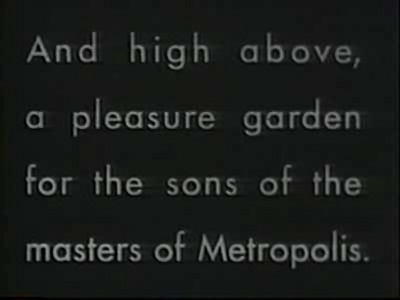
|
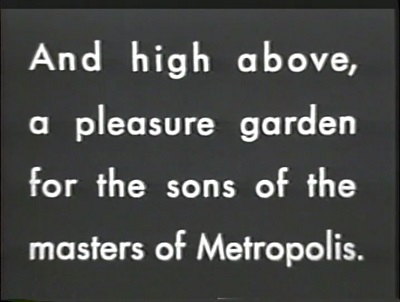
|
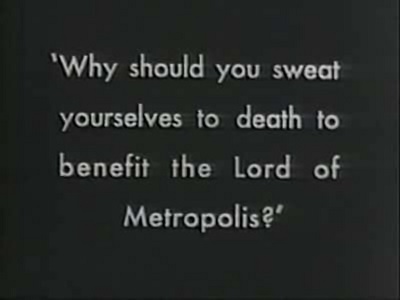
|
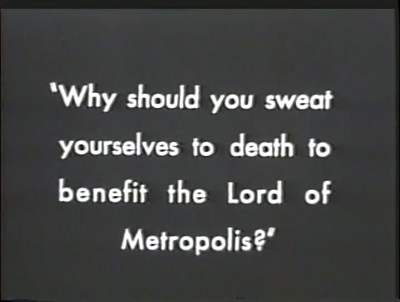
|
|
The Griggs edition was copied from MoMA’s print.
The Kino edition was copied from Nordwestdeutscher’s 1965 copy of the BFI edition.
Back in 1938, the MoMA edition and the BFI edition were identical in every way.
Why now are the titles slightly different?
Apparently, MoMA reset the titles for reasons unknown, some time after 1938 but before 1960.
The titles were reset in a new font that was almost identical with the old font.
Perhaps the older font was no longer on the market?
Notice that the titles are horizontally centered,
even though the the rest of the film was missing the left side and the height.
Why?
The title house that MoMA hired composed the titles for a .600"×.825" crop,
to be compatible with Ufa’s cropped lavender.
|
|
